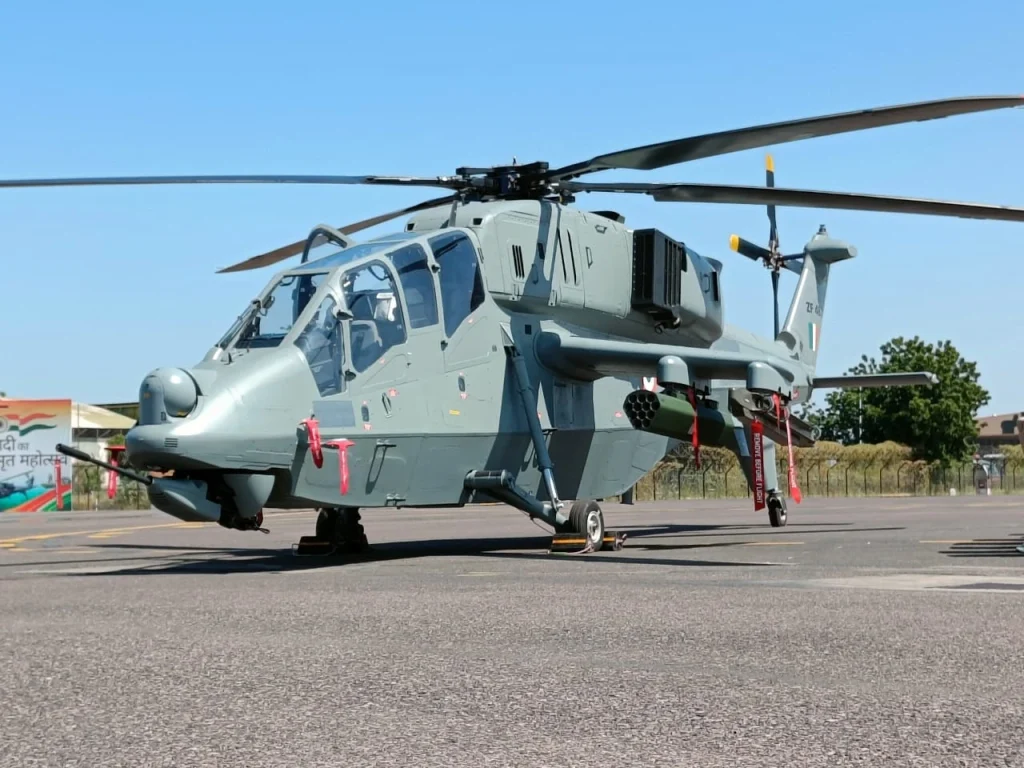The Indian Air Force (IAF) recently inducted Hindustan Aeronautics Ltd (HAL) Light Combat Helicopter (LCH), raising its first squadron of indigenously-built aircraft. The helicopter has been in the news because it is the only assault helicopter in the world capable of taking off and landing at altitudes of five kilometres while carrying considerable armament and fuel loads. The helicopter can meet the requirements of troops serving in areas such as Siachen and Kargil.
While this aircraft is being hailed as a great milestone for self-reliance in defence, it still requires a fair amount of work before it becomes fully operational.
Capabilities of Indigenous Prachand LCH
The Prachand is a chopper with a Low Observable (LO) design. It also has reduced infrared (IR) signatures and an IR suppressor. In addition, the aircraft has lessened radar, visual, and aural signatures. Weighing just 5.8-ton, the helicopter features canted panels for lower radar cross section (RCS), too.
Besides its detection-evasive capabilities, the helicopter has a top speed of 275 kmph (148 kt). Its combat radius spans a massive 500 km. The Prachand helicopter is also capable of high-altitude warfare with an operational ceiling of about 5,490 meters.
The aircraft’s stub wings/armament booms feature two weapon attachment stations on each side. Each one of these stations can carry Anti-tank Guided Missiles (ATGMs), rockets, or air-to-air missiles (AAM). Furthermore, the chopper has fixed armour plating on its sides. It has crash-worthy landing gear for better survivability.
The LCH features exceptional sensors, equipped with an Electro-Optical Pod consisting of a CCD camera, forward-looking infrared (FLIR), and Laser Range Finder (LRF). These sensors provide the attack helicopter with the ability to detect and acquire targets during the day or at night.
In early 2019, Prachand had already successfully engaged a moving aerial target with an AAM at the integrated test range in Odisha’s Chandipur. The air-to-air engagement has the distinction of being the first ever in the country by any helicopter. No other helicopter with military services in India has demonstrated an ability like this.
The LCH’s Arsenal
Although HAL omitted the details regarding which missile was used for trials in its announcement, earlier reports had referred to the European MBDA Mistral 2. It is important to note that the Mistral 2 is an optically aimed missile. That, along with the fact that the weapon system computer source code is indigenous to India, the country can integrate any AAM with an optical seeker.

The chopper’s anti-tank is based on the Helina ATGM. The range of this missile lies between 500 metres to seven km. Its seeker can also image the target alongside detecting it; this implies that the ATGM is capable of recognising a target and ignoring other heat sources around it.
In addition to such weapons, the Prachand is equipped with cluster bombs, a chin-mounted M621 20mm turret twin-barrel gun known for its high muzzle velocity and pinpoint accuracy, and 68mm rocket pods, the range of whose rockets is up to six km.
Potential Orders
HAL has successfully designed and manufactured the Prachand by following the efficient production path first seen in use with the Dhruv advanced light helicopter (ALH).
In March 2021, the Government of India (GoI) sanctioned the production of 15 Prachanda LCH for Rs 3,887 crore. The GoI also green-lit the expenditure of Rs 377 crore more on a production line. HAL, the maker of Prachanda LCHs, has been told to expect orders for 65 more of these helicopters for the IAF and 97 more for the Indian Army. The hint towards these orders serves as a testament to the LCH’s credibility.
Yet, certain issues with the chopper remain.
Details To Be Ironed Out
The indigenously built attack helicopter currently lacks its main arsenal and protection suites. Whispers in the hallways suggest that the tank buster will only get its ATGMs by mid-2023. Moreover, while the AAM launchers have been integrated, the order for the missile itself has not been placed.
The chopper will also require guided munitions if it has to counter man-portable air-defence systems (MANPADS)- surface-to-air missiles that can create many difficulties for a helicopter. While unguided weapons have substantial destructive power, guided munitions are better in combat, where getting close to the enemy to attack would be dangerous.
Yet another major improvement that the chopper is still wanting comes in terms of all-weather visibility. Given that it will operate in some of the world’s harshest-known areas, the aircraft will need to be able to operate in fog, haze, smoke, and rain. However, In its current development, the Prachand is optimised for clear weather operations only. The helicopters air-to-air capability is also restrained to good visibility conditions.
